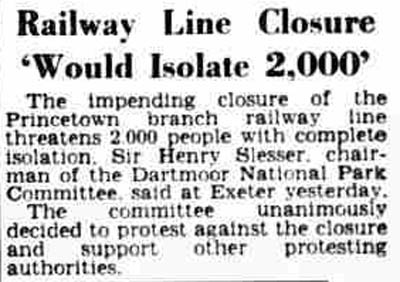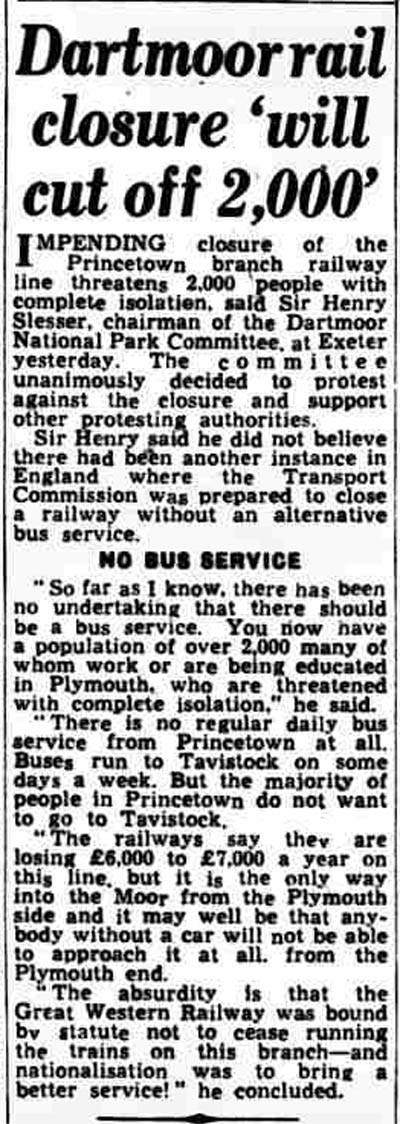Here is an article from my copy of Every Spotters Weekly 13 June 1953 written by R. C. Sambourne. Giving an insight into the branch three years before it’s closure in 1956.
The terminus of this branch stands 1,400 feet above sea level in the County of Devon and is claimed to be the highest station on the Western Region of British Railways. Situated in Princetown is the noted Dartmoor Prison, for which the railway partly operates.

The line was opened on August 11th, 1883 under the Princetown Railway Act of August 13th, 1878 and was worked by the Great Western Railway from the offset, becoming absorbed into the company as from January 1st, 1922 and being included in the nationalisation of the G.W.R. as from January 1st, 1948.
The line commences at Yelverton, on the Tavistock branch 11 miles from Plymouth and takes an exceptionally winding course around high rugged Tors, ascending severe gradients averaging 1 in 40 before reaching Princetown, a distance of 10 1/2 , miles. The direct road connecting the two points is only five miles.
The line is single throughout with no intermediate crossing places and is worked on an electric train staff. Dousland, the only block post, is a residential area on the outskirts of Dartmoor and is provided with a short siding having accommodation for approximately twelve trucks. There is also a ground frame for operating a level crossing.

The three stations, Princetown, Dousland and Yelverton are constructed of stone, containing the usual waiting room and booking hall, with signal box adjoining, except at Yelverton, where the box is situated on the Tavistock branch. There are also three halts, Burrator, King Tor and Ingra Tor. These are completely built of timber, just the length of one coach and with the exception of Ingra Tor a galvanized but is attached as a shelter for waiting passengers. Ingra Tor itself displays a solitary notice informing passengers to “Beware of Snakes.” These Halts are not observed during the hours of darkness.
From Burrator Halt one can get a glorious view of the lake, with the dam directly below holding the main sources of Plymouth’s water supply, while from King Tor and Ingra Tor Halts only barren moorlands with cultivated fields far to the West; incidentally these two Halts are within sight of each other at different heights, although the actual distance by rail is 2¾ miles.
The three level crossings at Lawry Road, Prowe’s and Dousland ground frame are protected by gates. The former set are always closed against road traffic; thus motorists who require to cross must notify the woman gate-keeper at the railway cottage beside the line. When a train is approaching a warning bell is sounded. The latter two crossings are worked by gate keepers here normal procedure is adopted of leaving the way clear to road traffic until a train is due.
Swell Tor siding between Ingra Tor and Kings Tor Halts, once used for quarry workings, is now closed and rails removed beyond the gate entrance, leaving only one siding for emergency purposes, such as storing trucks when permanent way repairs are in operation.
Services on the branch are worked by one engine with one non-corridor coach, or two coaches if required. The coach numbers are 6,218 and 6,213, each coach being marked in a bottom corner with “Return to Princetown.”
Motive power for the branch is supplied, as a rule, by a 2-6-2 tank of the 44xx class but now that this class is nearing extinction duties are sometimes performed by a 45xx class 2-6-2 tank.
With no difference in the summer and winter timetables there are five journeys a day, each way, Sunday excepted, with an additional journey each way on Saturdays. Departures from Princetown are at 7.35 a.m., 10.30 a.m., 12.8 p.m., 4.o p.m., 6.10 p.m., all trains being allowed 35 minutes to Yelverton.
Return journeys from Yelverton are at 9.4 a.m., 11.19 a.m., 2,28 p.m., 4.51 p.m. and 7.o p.m. The extra train on Saturdays leaves Yelverton at 1.22 p.m. and returns from Princetown at 2.12 p.m.; to allow running time the 2.28 p.m. from Yelverton is retimed to 2.52 p.m. The 12.8 p.m. from Princetown runs Tuesdays, Thursdays and Saturdays only whilst on Mondays, Wednesdays and Fridays this train departs at 12.35 p.m. and is known as the `Horrabridge Freight”; although a coach is attached no passengers are carried. This train continues beyond Yelverton to Horrabridge, the next station on towards Tavistock, there to drop empties and collect consignments for the branch. It departs from Horrabridge at 2.10 p.m., being known as the “Princetown Freight” as far as Yelverton, and thence, as the 2.28 p.m. Yelverton, proceeding as a Mixed-V2, from Yelverton, proceeding as a Mixed train.
Traffic is fairly steady on the branch and rather popular with hikers in the summer, these taking advantage of day excursion tickets.
At Yelverton Junction (although this term isn’t used), the train halts a short distance from the Tavistock branch and takes on water. Being a single line, the method adopted in turning is rather unique. The coach is pushed up an incline beyond a siding, the engine then runs into the siding, leaving the line clear for the coach to run back down to the platform under its own momentum. To complete the process the engine follows, connects up again and preparations are then made for another journey into the “Wilds of Dartmoor”.





